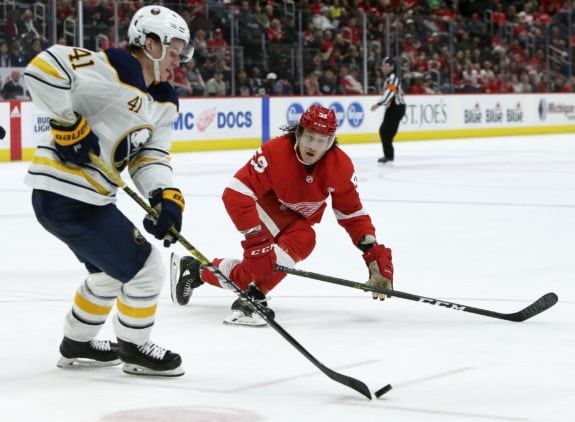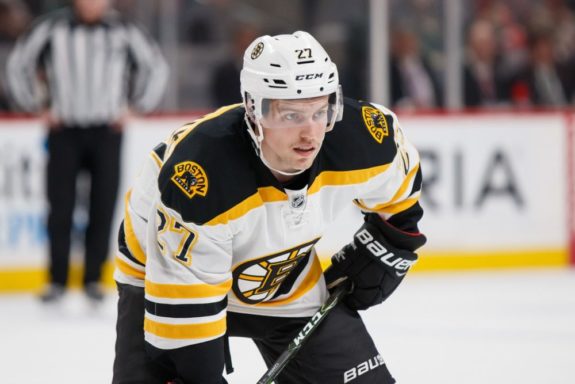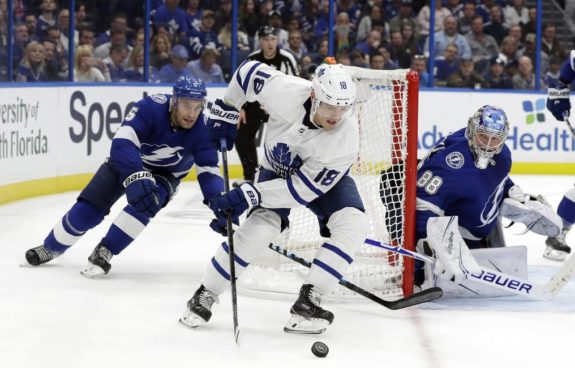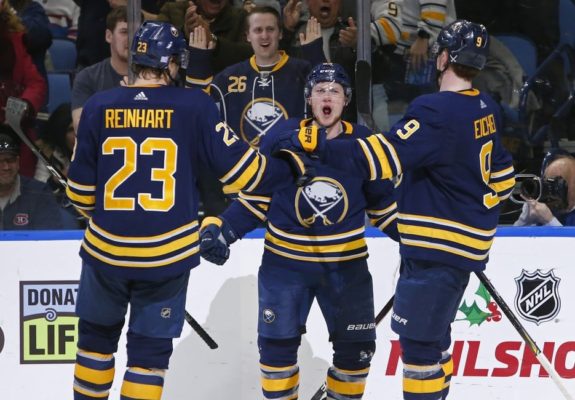Victor Olofsson has been keenly followed by Buffalo Sabres fans over the last couple seasons. Drafted in the seventh round, 181st overall, in the 2014 NHL Draft, he understandably was not welcomed with great fanfare. With the Sabres’ ineptitude at drafting beyond the top five in the draft, Olofsson was regarded as a name that would likely soon be forgotten.
As the 2017-18 season began to unfold, however, Olofsson started turning heads. Playing for Frolunda in the Swedish Hockey League, he was certainly not top of mind for most Sabres fans. They were able to see his points continue to pile up from afar, especially his goals. He finished the season as the league leader in goalscoring for the 2017-18 season.
After arriving in North America, expectations were beginning to grow. It was even speculated that Olofsson could spend the majority of the season with the Sabres. In reality, he ended up with 63 points in 66 games with the AHL Rochester Americans, including a team-leading 30 goals. He had a cup of coffee in Buffalo, scoring four points in six games as the Sabres played out the string at the end of another dismal season.
For a Sabres team starved for depth on offence, fans have big things in mind for Olofsson next season. Some feel he will see a natural progression from the AHL to the NHL and contribute 60 points, while others are much more conservative. What comparables are there to help us project his season?
Mason Black developed an offensive scoring stat called PNHLe. Describing how this system works, Black says, “PNHLe is an offensive stat that is used to project a player’s point potential at the NHL level and is meant to standardize a variety of leagues so that prospects can be compared from one league with another. PNHLe attempts to equalize all leagues, age and positions so that the offensive potential of a prospect can easily be compared with others, while also projecting future NHL point potential in the prime years of a player.”

While acknowledging that the stat isn’t a perfect predictor of success at the NHL level, it does provide a standardized way to compare prospects from an offensive perspective. Using PNHLe as a starting point, let’s establish a vantage point based on Olofsson’s rookie season.
Olofsson had a solid rookie campaign for Rochester. Leading the team in points and goals, he also had solid peripherals, according to prospect-stats.com. He finished at an elite level in each measurable stat. All things considered, Olofsson finished his rookie AHL season with a PNHLe rating of 32.7. Let’s now look at some players who closely compare to him.
Mark Jankowski
In his rookie season with the Stockton Heat, Jankowski tallied 56 points in 64 games as a 23-year-old. His PNHLe score was 35.9, 3.2 higher than Olofsson. Looking into some of theirdeeper numbers from prospect-stats.com, they were very comparable across most of the measurables with Olofsson having a distinct advantage at eTOI/GP.

In 2017-18, Jankowski played his rookie NHL season, putting up 25 points in 72 games.According to Evolving Hockey, his most common linemates that season were Sam Bennett and Garnet Hathaway. To find a common comparable stat, let’s compare their Expected Goal Differential. That season, Bennett had an onxG_diff of 2.3 and Hathaway was 3.68. Jankowski ended up finishing the season with an onxG_diff of 1.24.
Sadly, to find comparable linemates for Olofsson with the Sabres, you have to go straight to the top. This past season, Jack Eichel had an onxG_diff of 3.09 and Jason Pominville had 2.1. In essence, in order for Olofsson to be able to have commensurable deployment to Jankowski’s bottom-six role, he would need to play with two of Buffalo’s most complete players. One would hope that an increased offensive role could lead to an increase in points beyond the 25 that Jankowski scored.
Austin Czarnik
Another Calgary Flames prospect who closely compares to Olofsson is Austin Czarnik. He played his inaugural season with the Providence Bruins in 2015-16 as a 21-year-old pumping in 61 points in 68 games. That season, his PNHLe was 32.4, just 0.3 lower than Olofsson.
During his rookie season with the Boston Bruins in 2016-17, Czarnik mustered 13 points in 49 games as a 22-year-old. His most common linemates that season were Riley Nash and Matt Belesky. That season, Nash had an onxG_diff of 4.52, and Belesky, no longer in the NHL, was 1.09.

Suffice to say, Olofsson would again need to be paired with Eichel and Pominville to have a similar output to that of Czarnik. Czarnik, for his part, has yet to find a consistent role in the NHL. As a side-note…Looking back, it’s astonishing that depth players on other teams making significantly less money than the stars with the Sabres are having such a greater impact on the overall score-sheet. Things have been rough for the Sabres the last few seasons. But that’s another story...
Andreas Johnsson
Arguably the player that most Sabres fans point to when looking for comparables to Olofsson is Andreas Johnsson of the Toronto Maple Leafs. Johnsson was drafted in 2013, also in the seventh round. His rookie season with the AHL Toronto Marlies, like Olofsson’s, was played at the age of 23. Johnsson scored 47 points in 75 games. His PNHLe was 26.7, six below that of Olofsson.
During their rookie campaigns, the PNHLe narrative crosses over to their advanced stats as well. Olofsson showed much better in nearly every category compared to Johnsson. This is no doubt part of the reason that Johnsson went back down to the Marlies for the 2017-18 season, recording 54 points in 54 games.

While it’s not a perfect comparison of timeline due to Johnsson’s extra year of development, let’s look at Johnsson’s rookie season in the NHL. In 73 games with the Maple Leafs, Johnsson tallied 43 points, including 20 goals. A solid, impressive rookie season. His most common linemates were Auston Matthews and Kasperi Kapanen. Matthews had an onxG_diff of 6.93 while Kapanen, for his part, was 5.74.
Compared to the Sabres last season, those teammates simply don’t exist for Olofsson to play with in Buffalo. Even if he were to be paired with the Sabres’ two strongest players in terms of onxG_diff (Eichel and Jeff Skinner), their combined stat still only totals 6.12, less than that of Matthews alone. Olofsson certainly appears to be at a disadvantage going into what could be his inaugural NHL season.
Olofsson’s Expectations
Looking at recent history, we have now been able to establish a possible ceiling and floor for Olofsson. The floor could be Czarnik with .265 points-per-game. The ceiling could be Johnsson with .589 points-per-game. The reason that his expectations could be heightened is time on the man advantage.
All of the stats presented were at even strength. Olofsson is regarded as a power-play specialist with arguably the best shot on the Sabres. In his rookie season, Jankowski spent 57.95 minutes on the power play. Czarnik spent 83.53 his first season and Johnsson skated 115.13 with the extra man. If Olofsson does spend his season with the number one power-play unit for the Sabres, he will see significant time. Rasmus Ristolainen spent the fifth-most time on the man advantage with 228.28 minutes. Eichel spent the most, with 266.42 minutes.

If Olofsson were to receive in the neighbourhood of 250 minutes on the man advantage, he could have a significant edge on his comparables in the points department. If utilized properly with the right deployment, Olofsson could have a successful rookie season and potentially put himself in the Calder Trophy conversation.